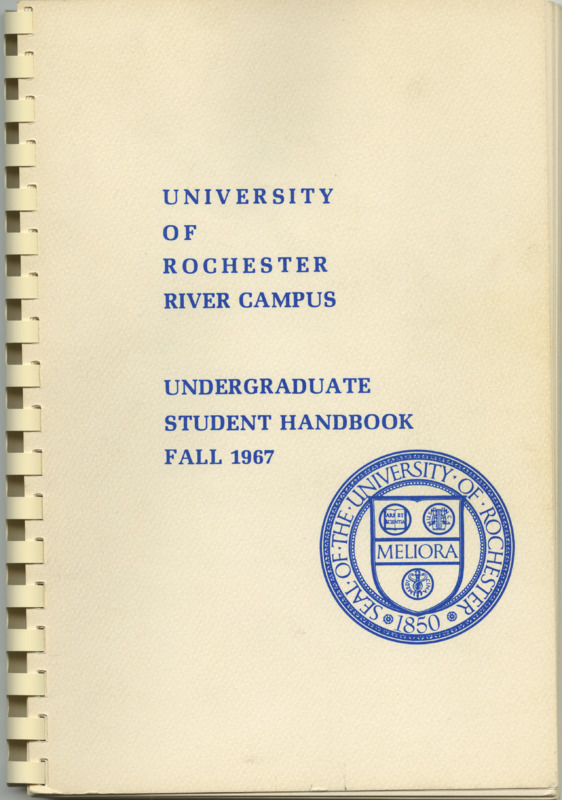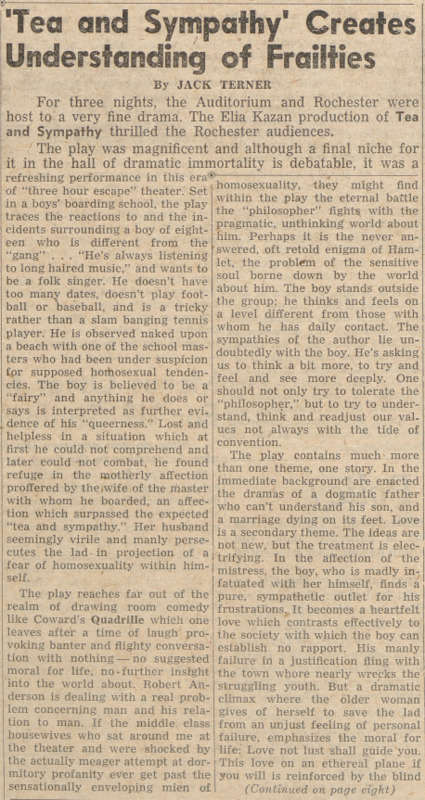1940s to 1960s
Pre-Stonewall
Before the 1970s there were few ways in which homosexuality could be openly discussed. At the University of Rochester, school policies and theatrical entertainment were two areas that made such mentions. Plays touching on homosexuality for humor or tragedy were put on by students or reviewed in the Campus Times. University policies policed student behavior deemed “aberrant” which explicitly included homosexuality.[2] Occasionally, the subject also arose in mentions of crime, perversion, and deviance. There would also be the sporadic study or book examining the science behind sexuality. Though these are infrequent and often impersonal mentions, they provide a base setting of the environment on campus. Homosexuality, while still deemed taboo, was not an unfamiliar topic; it could even be enjoyed through drama.
Sexual Abberrance
Several articles from the 1966-67 academic year raised issues with a university policy.[3] The policy in question deals with co-ed dorm visitation. The university, hoping to dissuade sexual relationships, intensified the policies for dorm visitation behavior.
Below is an excerpt from the Undergraduate Student Handbook from the Fall of 1967:
“That two principles will be the cornerstone of the policy to be established by Social Behavior Board to regulate the visitation program:
A. The University will not condone behavior, such as sexual intercourse, indecent exposure, or aberrant sexual activities by its students when these actions occur under the jurisdiction of University policies or facilities. Under either of these conditions the student or students involved make the University a partner for what might otherwise be a matter of individual choice.
The University espouses this principle for two reasons: Clinical judgement based on counseling college students and the considered judgement of many behavioral scientists suggest that premarital intercourse is not developmentally constructive for the majority of college students.
While freedom of thought is unfettered for all participants in a University community, unlimited freedom to act is not. Any one element (students, faculty, administrators, trustees, alumni, the public) in a University is limited in its actions by the nature of the interaction with these elements. Given the social character of the University, it is necessary to set limits on student sexual behavior which attempt to take into account the values and concerns of all the elements which make up the University community.
B. The university recognizes that a degree of relative privacy can be constructive for college students and on that basis supports a visitation program. Nevertheless, the University cannot provide absolute privacy for students. There will not be a practice of intruding upon students. However, students should be aware that they may be interrupted for a variety of reasons and are expected to conduct themselves in an appropriate manner."
Students feared that the policy would invade privacy and felt it was an attempt to police their private matters. The line most concerning was the condemnation of “behavior, such as sexual intercourse, indecent exposure, or aberrant sexual activities,” which lacked a clear definition. The policy created quite a stir for students, uneasy at the lack of specification which allowed for penalization for students’ personal lives and private behaviors. Articles and letters appeared in the Campus Times throughout the academic year asking for clarification from administrators.[4] One answer defined sexual aberrance to be “indecent exposure, homosexual activity, petting, [and] anything that would be considered aberrant by normal standards."[5] This answer, however, was subjective and exerted the morality standards of administration. A student rebuttal questions this further, asking:
“What is ‘sexual aberrance’? Is it restricted to such deviations as homosexuality and sodomy; or (as it is often used) does it mean any form of extensive sexual activity which does not culminate in genital coitus? Does ‘sexual aberrance’ include ‘very heavy petting’? ‘Light petting’? ‘Making out’? Where is the line drawn?”[6]
Students continued to investigate, critique, and even protest the policy. Another administrator commented in the spring of ‘67, contrarily asserting that sexual aberrance “covered only homosexuality.”[7] Despite the confusion and student protests, the policy remained, as is evident by the fall of the 1967 student handbook. The only aspect of this policy that was certain and agreed upon was the fact that it barred homosexuality. With the policy left intentionally vague, there were no clear answers as to what wasn’t aberrant sexual behavior. However, students and administrators alike could unanimously agree upon the fact that homosexuality was aberrant. While students complained about the restriction, policing, and potential punishment for their relations, no one defended or questioned that same scrutiny of homosexuality. General attitudes agreed that it was rightly condemned. Little did they know that a few short years later the university would be home to Rochester’s gay liberation movement.
One wonders about the gaps, what the closeted students felt about this policy, and how they lived underground before it became somewhat safe to connect and form an open community. As we know from the many retellings of the founding of the Gay Liberation Front, gay students were there -- people just didn’t know it.
Entertainment
One realm on campus in which homosexuality was somewhat acceptable was entertainment. Books, films, and theater could feature stories dealing with sexuality without total censorship. This would continue to thrive and change alongside the evolving cultural perceptions of sexuality and gender. The arts were historically a safer avenue to experiment with themes deemed taboo, allowing for representation to slowly seep into art before it was fully safe in day-to-day life. Of course, many of these representations were not ideal. However, to some capacity, one can infer societal views on homosexuality through depictions in fiction, theater, and art where lines could be blurred and more could be visible in the name of making believe.
- Tea and Sympathy: This 1950s play, featuring a homosexual storyline, graces the Rochester stage in November 1955. The Auditorium theater hosted “Tea and Sympathies,” which caught the attention of a University of Rochester student enough to warrant a play review for the Campus Times. The student’s review treats the play with reverence, admiring the complexity of the story and its challenges to societal norms. This review shows homosexuality on campus over a decade before the formation of the Gay Liberation Front. It shows a rare respectful mention of homosexuality from the era.
- Experiment ‘66: The Collection: A University of Rochester theatre troupe, the Experiment, performed "The Collection" by Harold Pinter in December 1965. The performance of this play, which features a homosexual couple, is complimented in the Campus Times. No negative comments were made about the homosexual plot, it is mentioned casually.
- Luv: In December 1968, the University of Rochester undergraduate drama group, the “Stagers”, performed "Luv" by Murray Schisgal. Among other themes, the play depicts homosexuality.
The University saw a handful of plays in the 1950s and 1960s, like those above, dealing with homosexual plots. Whether used as scandal, humor, or tragedy homosexuality was something people were consuming in the media. These plays created some degree of visibility for homosexuality. Audiences were slowly exposed to the subject matter which would soon erupt into a liberation movement. In studying LGBTQ+ history, one must assume that while these plays were being performed there were also gay students who didn’t make it into the records. There had to have been gay and lesbian students already there, waiting to one day find the strength to “take heart” and empty the closets of the University of Rochester.[8] These small mentions of homosexuality in entertainment relate the content that underground and closeted gay students could have acted in, watched, or read about. The scraps of representation show a glimpse into what these forgotten students may have had access to.





